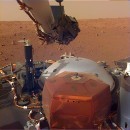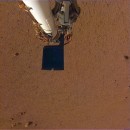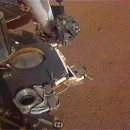Now that the landing of the InSight spacecraft on Mars was confirmed to have went without a hitch, NASA engineers have started testing the lander’s systems to see if everything is in working order.
The first order of business was to see whether the 6 feet (2 meters) robotic arm can be extended, as it is the main tool which will be used to pick up science instruments from the lander's deck and set them down on the surface to do their thing.
In a new set of images released by NASA on Thursday, the InSight shows its arm is working. The first thing it will have to do is use the Instrument Deployment Camera and take some snapshots of the surrounding area in the Elysium Planitia. This is a means for scientists to check for the best place to set the main instruments deployed on the lander.
The placement of these instruments will be critical to the success of the mission. The first is the SEIS (Seismic Experiment for Interior Structure), which will be used to look for Marsquakes by measuring the ground motions over a wide range of frequencies.
The second, RISE (Rotation and Interior Structure Experiment) will assess perturbations of Mars' rotation axis, while a third too, HP3 (Heat Flow and Physical Properties Package, will dig 10 to 16 feet (3 to 5 meters) holes into the Martian surface and place sensors to determine the amount of heat escaping from the planet's interior).
This is the first time humans have attempted to look under the surface of an alien planet. Hence this is a very important moment for all parties involved.
"We did extensive testing on Earth. But we know that everything is a little different for the lander on Mars, so faults are not unusual," said in a statement Tom Hoffman of JPL, InSight's project manager.
"They can delay operations, but we're not in a rush. We want to be sure that each operation that we perform on Mars is safe, so we set our safety monitors to be fairly sensitive initially."
In a new set of images released by NASA on Thursday, the InSight shows its arm is working. The first thing it will have to do is use the Instrument Deployment Camera and take some snapshots of the surrounding area in the Elysium Planitia. This is a means for scientists to check for the best place to set the main instruments deployed on the lander.
The placement of these instruments will be critical to the success of the mission. The first is the SEIS (Seismic Experiment for Interior Structure), which will be used to look for Marsquakes by measuring the ground motions over a wide range of frequencies.
The second, RISE (Rotation and Interior Structure Experiment) will assess perturbations of Mars' rotation axis, while a third too, HP3 (Heat Flow and Physical Properties Package, will dig 10 to 16 feet (3 to 5 meters) holes into the Martian surface and place sensors to determine the amount of heat escaping from the planet's interior).
This is the first time humans have attempted to look under the surface of an alien planet. Hence this is a very important moment for all parties involved.
"We did extensive testing on Earth. But we know that everything is a little different for the lander on Mars, so faults are not unusual," said in a statement Tom Hoffman of JPL, InSight's project manager.
"They can delay operations, but we're not in a rush. We want to be sure that each operation that we perform on Mars is safe, so we set our safety monitors to be fairly sensitive initially."




